Investigation into monkeypox outbreak in England: technical briefing 4
Updated 19 December 2024
Applies to England
This technical briefing includes limited data on cases confirmed UK-wide, where available.
The UK Health Security Agency (UKHSA) is working with the NHS and the public health agencies of the 4 nations to investigate the monkeypox outbreak. This briefing is produced to share data useful to other public health investigators and academic partners undertaking related work. It includes early evidence and preliminary analyses which may be subject to change.
Data reported in the technical briefing is as of 18 July 2022 (or as specified in the text) to allow time for analysis.
Potential levels of the outbreak in England
The outbreak can be considered to fall into one of 4 potential levels of transmission:
Level 1
Incursions from rest of the world – small numbers of imported cases with limited onward transmission.
Level 2
Transmission within a defined sub-population.
Level 3
Transmission within multiple sub-populations or larger sub-population.
Level 4
Wider significant community transmission – with potential for endemic and local epi-zoonotic disease.
These may be refined with better understanding of modes of transmission.
At present, England is judged to be in Level 2 and is being closely monitored for any evidence of Level 3.
Risk assessment as of 19 July 2022
UK trajectory
Nowcast and growth
Based on the most recent case data, daily case growth has likely slowed. Depending on the exact data and modelling techniques used, the number of daily confirmed cases may still be increasing slightly or may be levelling off. Potential changes in case ascertainment make this challenging to interpret.
Recent reduction in daily case growth (moderate).
Geographic spread
The proportion of cases resident in London was more than 75% from the start of the incident up to 20 June 2022. This proportion declined to just over 60% in early July and has stayed at around 66% of cases since then.
Remaining concentrated in London (moderate) but with evidence of increasing geographic spread (low).
Ascertainment
Whilst testing is freely available and a mixed population group is being tested, it is likely that there is under ascertainment. Atypical symptoms, including single or scarce lesions, are reported and there are international reports of subclinical infection. Of the 2,050 cases in England, only 8% (157) were also named as contacts by a confirmed case.
Assessment (confidence): insufficient information
UK transmission
Outbreak level
Level 2 is defined as transmission within a defined sub-population, currently GBMSM connected by sexual networks. Enhanced surveillance data does not suggest a change in case mix, although it is available on only 28% (576 out of 2,070) of cases and may not be representative of the whole cohort. There are 13 female cases in England (out of 2,014 with known gender). There is no robust evidence of sustained transmission outside some sexual networks of GBMSM, although the increase in female cases requires close surveillance.
Assessment (confidence): level 2 (moderate).
Route of transmission
Whilst the primary reported route is through close or sexual contact, monkeypox virus has been detected in air and environmental samples in the hospital room of infected patients. There are no confirmed instances of airborne transmission. Limited household transmission has been described in the UK.
Assessment (confidence): transmitting primarily through close or sexual contact (moderate).
Severity
Observed clinical severity
Hospitalisation data is currently being updated. There are no reported deaths in the UK. There is significant morbidity in the majority of people who are admitted to hospital for clinical care reasons, including severe pain and complications due to secondary bacterial infection.
Assessment (confidence): in current population group, low mortality but significant morbidity (moderate). In wider population, insufficient data.
Virological characterisation
Outbreak cases are currently in a distinct clade which has mutations of unknown significance. There is evidence suggestive of sustained human transmission prior to the 2022 outbreak but not clear-cut evidence of adaptation for improved human transmission. There are no phenotypic data available for this clade to date.
Assessment (confidence): insufficient data.
International trajectory
Global growth
The number of cases reported internationally continues to increase and is most compatible with growth, although ascertainment is also likely to be increasing in some countries.
Assessment (confidence): the global outbreak is growing (high).
International transmission
Routes of transmission reported by other countries
Cases in previously non-endemic countries are reported as primarily in GBMSM. Small number of cases are reported in women and children. In countries with a longer history of monkeypox, apparent wider population transmission is reported with unclear routes. Phylogenetic data suggests that human transmission has been occurring for a number of years in some areas prior to the appearance of the outbreak clade and there is at present no reason to assume that the epidemic as a whole will naturally reduce without interventions globally.
Assessment (confidence): transmitting primarily by close or sexual contact in non-endemic countries (low). Unknown transmission routes in endemic countries.
Epidemiology update
Current epidemiological situation
Cases of monkeypox infection were confirmed in England from 6 May 2022. As of 20 July 2022, there were 2,162 laboratory confirmed cases in the UK. Of the confirmed cases 54 were in Scotland, 14 in Northern Ireland, 24 in Wales and 2,070 were in England. The median age of confirmed cases in the UK was 37 years old (interquartile range 31 to 43).
Table 1. Number of laboratory confirmed cases by devolved administrations, 6 May 2022 to 20 July 2022
| Devolved administrations | Confirmed cases |
|---|---|
| England | 2,070 |
| Northern Ireland | 14 |
| Scotland | 54 |
| Wales | 24 |
| Total | 2,162 |
In England, a high proportion of cases were known to be London residents (overall 74%, 1,513 out of 2,054 with reported home address) (Table 2). The number of cases in other regions has been steadily increasing, particularly in the south east of England (Figure 1). Accordingly, the proportion of cases in London has declined, to just over 60% in early July 2022, but has stayed around 66% of cases since then (Figure 2).
Table 2. Number of laboratory confirmed monkeypox cases by region of residence, England, March 2022 to 20 July 2022
| Region of residence | Total confirmed |
|---|---|
| East of England | 86 |
| East Midlands | 25 |
| London | 1,513 |
| North East | 22 |
| North West | 114 |
| South East | 174 |
| South West | 34 |
| West Midlands | 51 |
| Yorkshire and Humber | 35 |
| Unknown* | 16 |
| Total | 2,070 |
*Address not yet confirmed.
Figure 1. Cumulative monkeypox case count by region of residence in England as of 20 July 2022
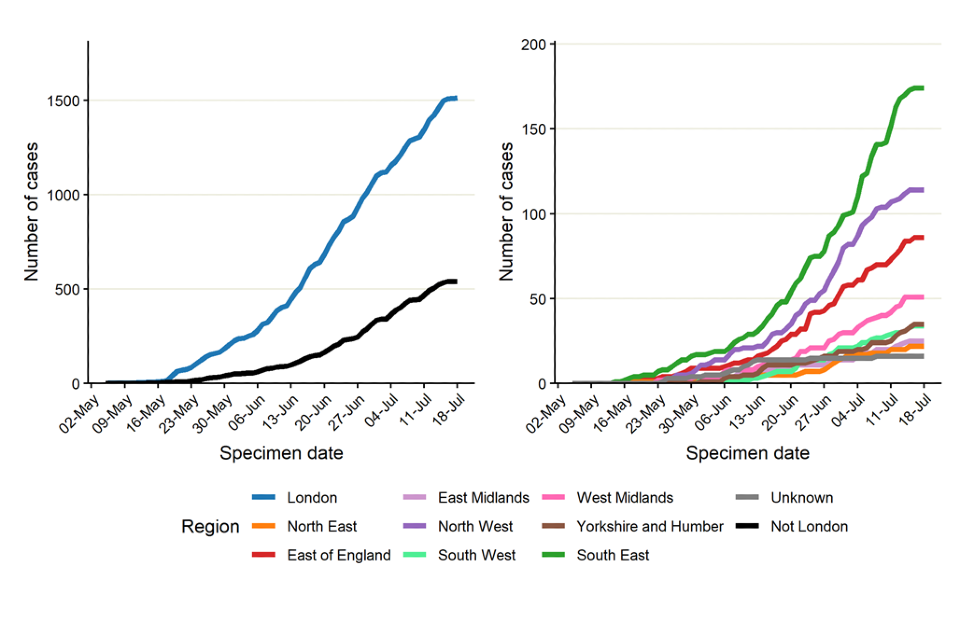
The data used in this graph can be found in the accompanying spreadsheet.
Figure 2. 7 day rolling average of the percentage of monkeypox cases in London, by specimen date

The data used in this graph can be found in the accompanying spreadsheet.
Figure 3 demonstrates symptom onset dates of confirmed cases in England, where known. The median reporting delay, calculated here as the time between symptom onset date and date first included in UKHSA surveillance data, was 11 days for cases newly reported in the week starting 11 July 2022. Figure 4 shows the number of confirmed monkeypox cases by specimen date. Where gender information was available, 2,001 out of 2,014 (99%) confirmed cases in England were male, with 13 confirmed female cases.
Recent foreign travel, within 21 days prior to symptom onset, was reported by 317 cases in England (15%), with 252 of these reporting travel within Europe (Figure 6). Travel was more common among cases reported in May 2022 and early June 2022.
Figure 3. Confirmed monkeypox cases by symptom onset date in England as of 20 July 2022
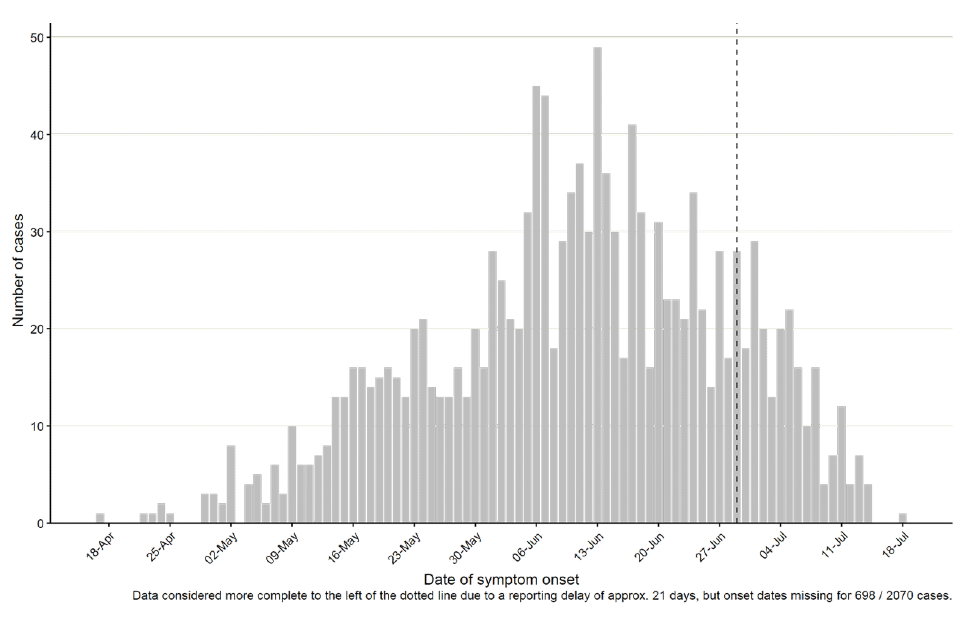
The data used in this graph can be found in the accompanying spreadsheet.
Figure 4. Incidence of confirmed monkeypox cases by specimen date in England as of 20 July 2022
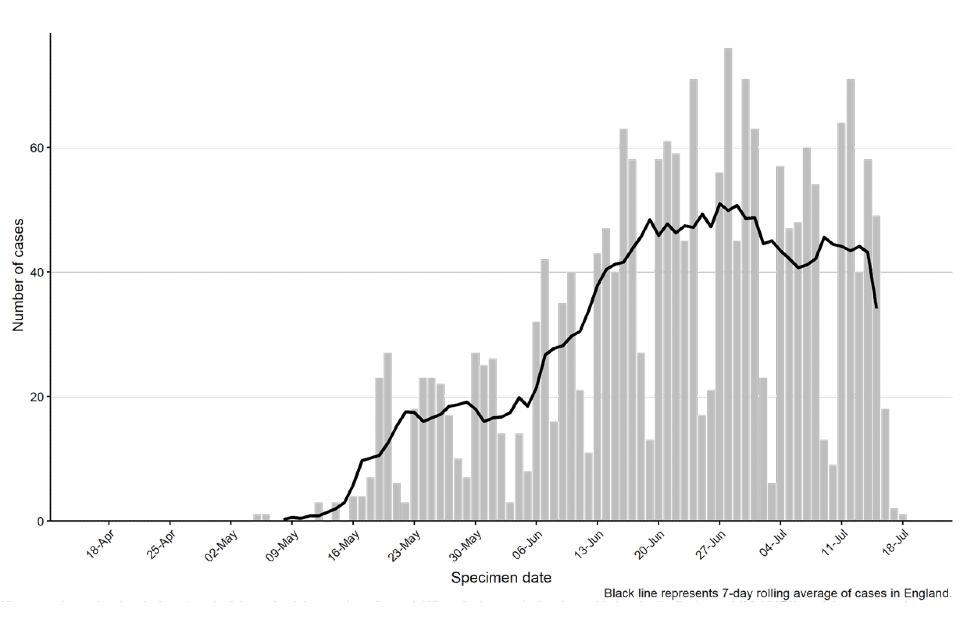
Where specimen date is missing, the date the laboratory received the specimen is used. Where both are missing, date added to the line list is used (32 out of 2,070), mainly among early cases. The data used in this graph can be found in the accompanying spreadsheet.
Figure 5. Age and gender distribution of confirmed monkeypox cases by laboratory result date in England as of 20 July 2022

The data used in this graph can be found in the accompanying spreadsheet.
Figure 6. Cases with reported foreign travel within the 21 days prior to symptom onset as of 20 July 2022
Travel data obtained from enhanced surveillance questionnaires and public health records (HPZone)

The data used in this graph can be found in the accompanying spreadsheet.
Findings from enhanced surveillance questionnaires
Of the 2,070 cases identified in England up to 20 July 2022, a total of 576 (28%) had enhanced surveillance questionnaires. This includes data collected via rapid sexual health questionnaires administered during the initial weeks of the outbreak (used from 27 to 31 May 2022), questionnaires completed by health protection teams during telephone interviews (used from 1 to 24 June 2022), and self-completed questionnaires sent electronically to cases (used from 25 June 2022 onwards). Information from enhanced questionnaires should be interpreted with caution, as this is available for less than 30% of cases. People completing questionnaires may not be representative of all those affected.
As reported in previous technical briefings, monkeypox is predominantly being transmitted in interconnected sexual networks of GBMSM (Table 3).
Table 3. Selected epidemiological metrics from enhanced surveillance questionnaires in confirmed monkeypox cases in England as of 19 July 2022
N=576, some metrics have slightly smaller denominators due to missing values
| Metric | N (%) | |
|---|---|---|
| Gay, bisexual, or men who have sex with men* | 549 (96.5%) | |
| Travel abroad prior to symptom onset (21 days) | 173 (30.3%) | |
| Age below 30 years | 98 (22.9%) | |
| History of STI in the last year | 313 (55.6%) | |
| One or no sexual partners in last 3 months | 82 (14.5%) | |
| 10+ sexual partners in last 3 months | 176 (31.1%) | |
| Living with HIV | 149 (27.7%) | |
| On HIV treatment (among living with HIV) | 148 (99.3%) | |
| Ever used PrEP (among HIV negative) | 297 (79.2%) |
*Includes men who self-identify as GBMSM or reported sex with a man in the 21 days prior to symptom onset. Proportion is calculated among 569 males only.
Figure 7 shows trends of selected epidemiological metrics in a subset of 544 cases with completed questionnaires who had symptom onset dates between epidemiological weeks 18 to 26 (from 1 May 2022 to 2 July 2022). Cases with onset dates before or after these dates were excluded from these analyses due to small numbers. Questionnaire data shows that, between epidemiological weeks 18 to 26, there was no significant change to selected epidemiological metrics among cases who responded to the questionnaire, suggesting transmission of monkeypox virus in England was continuing to occur in defined sexual networks of GBMSM. Notable changes in the most recent week may be due to low numbers and will continue to be monitored.
Figure 7. Trends of selected epidemiological metrics in confirmed monkeypox cases by week of symptom onset in England, epidemiological weeks 18 to 26 (1 May 2022 to 2 July 2022)
N = 544 with completed questionnaires in this time period, more recent weeks with lower numbers censored

Supplementary data is not available for this figure. Due to delays between symptom onset and questionnaire completion, data for the most recent epidemiological weeks may change and should be interpreted with caution.
Event attendance, and common exposure settings
People with confirmed monkeypox were asked about attendance at venues and events during the time period when they may have acquired the infection, and attendance when they may have been infectious. This included attendance at festivals, events, sex-on premises venues (including gay saunas and sex clubs), private sex parties, nightclubs, bars, gyms or swimming pools. Information was collated from enhanced case and rapid sexual health questionnaires, and from HPZone records.
In total, 654 venue or event attendances were reported by 274 individuals as of 19 July 2022. The majority of these attendances were during the period when cases may have acquired the infection. The most frequently reported event type was festivals, followed by sex-on-premise venues. Note that attendance is not evidence that transmission occurred at that venue or event, and individuals may have attended multiple events.
Table 4. Event attendance among confirmed monkeypox cases in England as of 19 July 2022
| Event type* | % of total (n) |
|---|---|
| Festival | 37% (241) |
| Sex-on-premise venue | 25% (164) |
| Bar | 12% (80) |
| Nightclub | 9% (60) |
| Gym or swimming pools | 7% (44) |
| Event | 4% (27) |
| Private sex party | 4% (26) |
| Other | 2% (12) |
| Total | 100% (654)** |
*Some cases have attended the same festival or event over multiple dates; each date has been reported separately.
**654 event or venue attendances reported by 274 unique cases.
As of 19 July 2022, 188 cases reported 313 attendances at venues or events in London, and 38 cases reported 57 attendances at venues or events elsewhere in England. A total of 73 cases reported 284 attendances at non-UK venues or events. These included festivals and venues in Spain (including Gran Canaria), Belgium and Israel.
Common exposures were defined as instances where 2 or more people with confirmed monkeypox reported attending the same event or venue on the same day. As of 19 July 2022, there were 27 common exposures in London. The most frequently reported type of common exposure was at sex-on-premise venues. Only one common exposure was identified elsewhere in England, in the North West region. Internationally, 36 common exposures were identified.
Figure 8. Timeline of common exposures at London venues or events among confirmed cases during their incubation and/or infectious period based on self-reported attendances
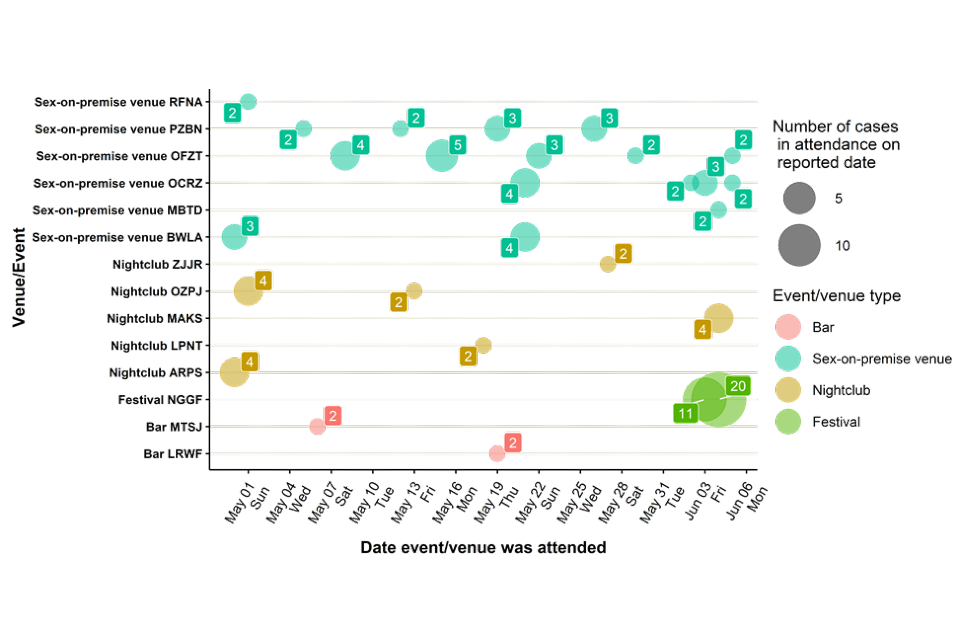
The data used in this graph can be found in the accompanying spreadsheet.
Source: event activity reported in enhanced case and rapid sexual health questionnaires, or manually extracted from case notes on HPZone. Data may be subject to reporting bias, and is likely to underestimate the true number of common exposures given the low uptake of questionnaire responses
Only events with at least 2 cases in attendance on a given date are included. A total of 27 attendances were excluded as no date was provided.
Figure 9. Timeline of common exposures at venues or events outside the United Kingdom among confirmed cases during their incubation and/or infectious period based on self-reported attendances
The data used in this graph can be found in the accompanying spreadsheet.
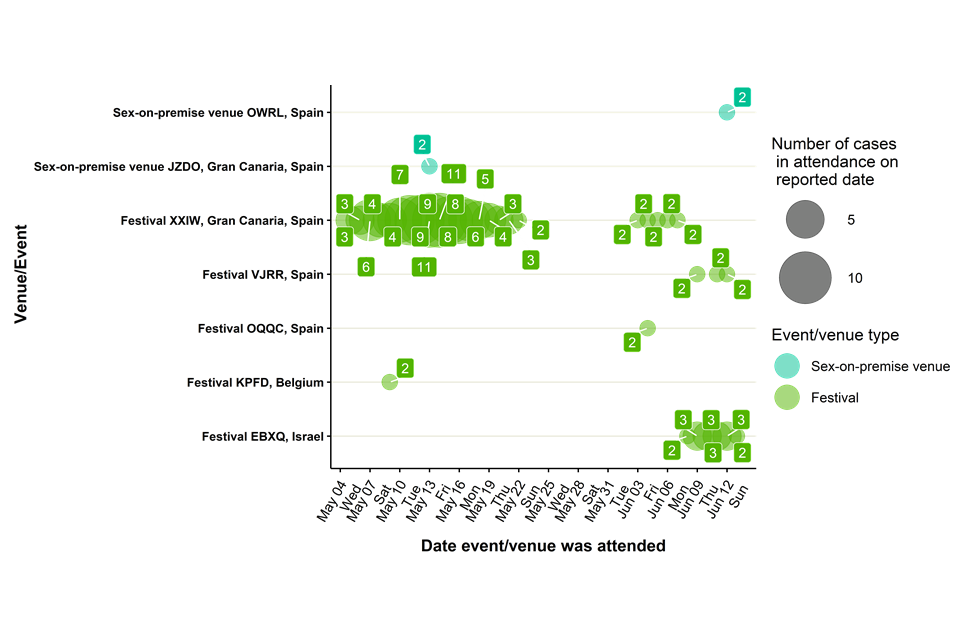
Source: event activity reported in enhanced case and rapid sexual health questionnaires, or manually extracted from case notes on HPZone. Data may be subject to reporting bias and is likely to underestimate the true number of common exposures given the low uptake of questionnaire responses.
Only events with at least 2 cases in attendance on a given date are included. A total of 9 attendances were excluded as no date was provided.
Contact data
Information on named contacts is collected by UKHSA. This is not expected to be a complete data set, as not all contacts may have been disclosed, or may not have been known or able to be named by the case (this is likely to affect sexual contacts in particular). A total of 2,413 contacts were named to UKHSA by cases reported from 9 May 2022 to 18 July 2022. These contacts were named by a case without consideration of date of exposure or onset and may represent exposures during incubation or infectious periods. Among all named contacts, while setting of the contact is often not clearly ascertained, at least 459 (19%) were listed as sexual contacts.
Of these named contacts, 157 were also known to be cases. This was 8% of all the 2,050 cases in England on 18 July 2022. Being named as a contact is not evidence of where transmission, or even exposure, may have occurred.
Information on likely exposure or transmission events is often missing, and significant uncertainties remain around the information collected.
2.5 Testing data
Between 1 May 2022 and 20 July 2022, 4,335 people underwent orthopox screening and monkeypox testing in UKHSA.
More adult men were screened for orthopox virus (3,467, 80% of all tests) compared to adult woman (447, 10% of all tests) and children (173, 4%). Monkeypox positivity rate was considerably higher in adult men, 54%, compared to 2.2% in adult women and 0.6% in children.
Table 5. Monkeypox positivity rate by group, as of 20 July 2022
| Group | Result | Total | Positivity Rate |
|---|---|---|---|
| Adult men1 | Negative | 1,603 | N/A |
| Adult men1 | Positive | 1,864 | 53.8 |
| Adult unknown2 | Negative | 151 | N/A |
| Adult unknown2 | Positive | 90 | 37.34 |
| Adult women3 | Negative | 437 | N/A |
| Adult women3 | Positive | 10 | 2.24 |
| Children4 | Negative | 172 | N/A |
| Children4 | Positive | 1 | 0.58 |
| Sex and age unknown5 | Negative | 5 | N/A |
| Sex and age unknown5 | Positive | 2 | 28.57 |
[1] Any person categorised as male and over 15 years old.
[2] Any person that provided no information on sex and over 15 years old.
[3] Any person categorised as female and over 15 years old.
[4] Any person (of either sex) aged between 0 and 15 years old.
[5] Any person with no information on sex or age.
Transmission dynamics
There is evidence that the transmission rate has slowed since technical briefing 3. Nowcasting by specimen date suggests the epidemic might have plateaued in recent weeks, but the current trajectory is highly uncertain.
Nowcasting by specimen date
As the epidemic has grown, the availability of data with recorded symptom onset date has declined. This biases the epidemic curve by symptom onset date, since the proportion of cases being recorded will decay over time, even when adjusting for reporting delays. Therefore, here we model the epidemic using specimen date, which is the date the sample is collected from a patient. This reflects an epidemic curve lagged by the delay between infection and seeking healthcare.
Visualising the epidemic curve by specimen date is affected by the delay from specimen date to the case being reported to UKHSA. To correct for this delay, nowcasting methods adjust the observed data by the distribution of reporting delays to create predictions of the actual frequency. We use a generalised additive model to nowcast current cases and apply this to non-travel associated cases in England.
The nowcasting suggests that the growth in confirmed daily cases is around zero, but with very high uncertainty (Figure 10), with growth rates estimated between a 23-day doubling time and a 24-day halving time. Negative doubling times represent halving times. A 24-day halving time is consistent with the epidemic shrinking. The swathe that spans zero shows growth has slowed and may now be close to zero.
Figure 10. Estimates of nowcast growth rate of monkeypox cases in England (A) and incidence (B)
The charts exclude cases associated with travel. The shaded area is the 90% credible Interval (CrI), the dark shaded area is the 50% CrI and the lighter area is the 90% CrI.
Figure 10A
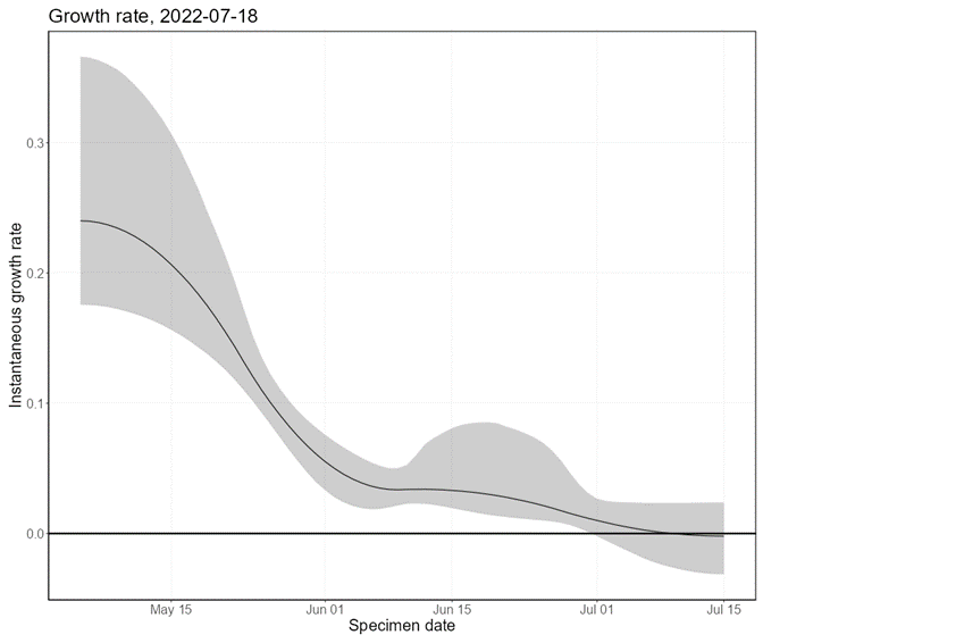
Figure 10B

Note: the y-axis denotes incidence of cases by specimen date. Supplementary data is not available for these figures.
Temporal trends in gender distribution
Thus far, the majority of cases have occurred in defined networks of GBMSM. To assess whether the outbreak is moving away from this initial subpopulation, we investigate temporal trends in the proportion of cases that do not identify as female. Assuming monkeypox is being transmitted in sexual networks of GBMSM, the proportion of cases that identify as female should remain constant (allowing for random fluctuations in the observed proportion).
A small number of sporadic transmission events from GBMSM networks to women is expected. However, if the proportion of cases in females is increasing, this could suggest that there is sustained transmission outside networks of GBMSM.
To assess the evidence, we construct a null hypothesis of no change in the transmission network based on the gender-distribution of cases over the last 6 weeks. We then adjust this observed proportion to the number of cases in the current week, to create a 95% confidence region where we would expect the currently observed gender-distribution to lie if it follows the null hypothesis. By overlaying the currently observed gender-distribution, we can identify statistically significant perturbations.
Note that although statistically significant, these perturbations may not reflect underlying transmission changes, since it could also be affected by changes in the relative ascertainment of female cases relative to male or unknown cases. We plot the statistical test as a rolling function of time for each week of the outbreak.
Currently, the proportion of female cases is consistent with the null hypothesis, so there is insufficient evidence to support a change in the transmission dynamics (Figure 11). However, over the last few weeks the proportion of female cases has been increasing, so this trend needs to be monitored closely.
Figure 11. Binomial probability of male cases using a Binomial exact test
The purple shaded area is the null hypothesis (which implies no change in the rate). The solid black line is the proportion observed in the latest week, plotted by the first day of the focal week.

Supplementary data is not available for this figure.
Clinical experience
Increasing clinical experience in the NHS enables us to better describe the clinical syndrome associated with the current outbreak of monkeypox including eliciting previously unknown signs and symptoms. This data will allow us to refine case definitions and improve clinical management of patients with early recognition of developing complications by patients and clinicians. More details are described in monkeypox technical briefing 3.
A total of 13 adult female patients have been diagnosed with monkeypox since 6 May 2022 in England. The clinical presentation of female cases has included fever, lymphadenopathy, oropharyngeal and genital lesions. The spectrum of clinical disease in female patients includes severe manifestations, with at least 4 requiring admission to hospital for management of symptoms directly related to monkeypox.
Sources and acknowledgments
Data sources
Monkeypox virus PCR results are submitted to UKHSA daily by the Rare and Imported Pathogens Laboratory, Porton, UKHSA regional laboratories and NHS laboratories undertaking testing. Data on people testing positive since 6 May 2022 is enhanced with demographic, symptom, epidemiological, and exposure information extracted from the UKHSA Health Protection Team case management system (HPZone), or collected in enhanced surveillance questionnaires. Enhanced surveillance questionnaires include data collected via rapid sexual health questionnaires administered during the initial weeks of the outbreak (used from 27 to 31 May 2022), questionnaires completed by health protection teams during telephone interviews (used from 1 to 24 June 2022), and self-completed questionnaires sent electronically to cases (used from 25 June 2022 onwards).
Authors of this report
Zahidul Abedin, Charlotte Anderson, Carolina Arevalo, Sooria Balasegaram, Paula Blomquist, Jessica Bridgen, Chloe Byers, Helen Callaby, Meera Chand, Rachel Christie, Fergus Cumming, Jake Dunning, Ashley Goddard, Irene Gonsalvez, Claire Gordon, Diane Hatziioanou, Susan Hopkins, Tim Laurence, Geraldine O’Hara, Christopher Overton, Karthik Paranthaman, Mateo Prochazka, Tommy Rampling, Cian Ryan, Roberto Vivancos, Dominic Wakerley, Thomas Ward, William Welfare, Katie Wrenn, Jin-Min Yuan.
Contributors
UKHSA Data, Epidemiology and Analytics Cell
UKHSA Research and Science Cell
UKHSA Modelling Cell
UKHSA Genomics Public Health Analysis
UKHSA Sexual Health Liaison Group
UKHSA Monkeypox Incident Management Team
Monkeypox Technical Group
The monkeypox technical group includes members with expertise in clinical infectious diseases, clinical research, epidemiology, genomics, modelling and virology.
| Person | Institution |
|---|---|
| Meera Chand (Chair) | UKHSA |
| Andre Charlett | UKHSA |
| Allan Bennett | UKHSA |
| Calum Semple | University of Liverpool |
| Christophe Fraser | University of Oxford |
| Claire Dewsnap | British Association for Sexual Health and HIV |
| Erik Volz | Imperial College London |
| Emma Thomson | Medical Research Council-University of Glasgow Centre for Virus Research |
| Fergus Cumming | UKHSA |
| Giri Shankar | Public Health Wales |
| Geoffrey L. Smith | University of Cambridge |
| Geraldine O’Hara | High Consequence Infectious Diseases Network |
| Helen Fifer | UKHSA |
| Isabel Oliver | UKHSA |
| Jake Dunning | University of Oxford and Royal Free Hospital |
| Jason Mercer | University of Birmingham |
| Maria Rossi | Public Health Scotland |
| Matt Keeling | Warwick University |
| Matt Phillips | British Association for Sexual Health and HIV |
| Neil Ferguson | Imperial College London |
| Obaghe Edeghere | UKHSA |
| Health and Social Care Northern Ireland | |
| Richard Myers | UKHSA |
| Steven Riley | UKHSA |
| Susan Hopkins | UKHSA |
| Tommy Rampling | UKHSA |
Acknowledgements
The authors are grateful to those teams and groups providing data for these analyses including:
- British HIV Association (BHIVA)
- British Association for Sexual Health and HIV (BASHH)
- Sexual Health Services
- NHS England and Improvement
- High Consequence Infectious Diseases Network
- Public Health Scotland
- Public Health Wales
- Public Health Agency, Northern Ireland
